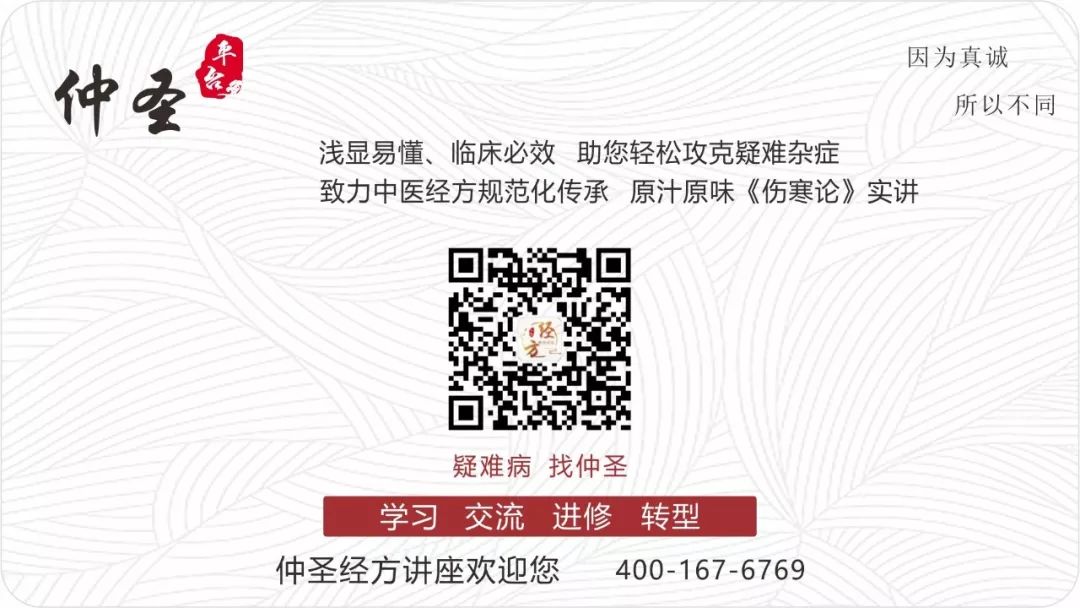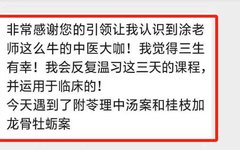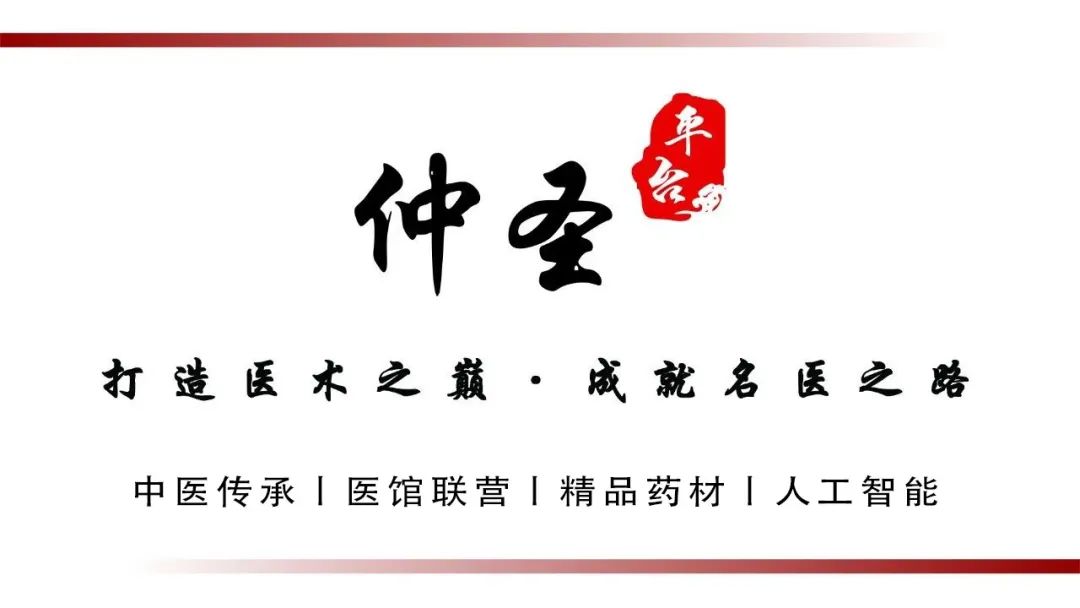


From the perspective of Traditional Chinese Medicine (TCM), Yin and Yang not only constitute the human body but also serve as the fundamental substances that maintain life activities. The essence, blood, and body fluids within the human body belong to Yin due to their relative stillness, while Qi belongs to Yang due to its relative movement. Here’s a good formula to secure Yang Qi and converge Yin Qi; let’s take a look!

 Gui Zhi Jia Long Gu Mu Li Tang (Cinnamon Twig Decoction with Dragon Bone and Oyster)
Gui Zhi Jia Long Gu Mu Li Tang (Cinnamon Twig Decoction with Dragon Bone and Oyster)
The formula Gui Zhi Jia Long Gu Mu Li Tang is from the medical sage Zhang Zhongjing’s “Jin Kui Yao Lue – Blood Bi and Xu Lao Disease Pulse Diagnosis and Treatment,” originally stated as:
“If a man loses essence, he will have a tight and painful lower abdomen, cold in the Yin region, dizziness (or pain in the eye sockets). Hair loss, pulse extremely weak and thin, indicating loss of blood and essence. If the pulse is slightly tight and moving, it indicates loss of essence in men and dream intercourse in women; Gui Zhi Jia Long Gu Mu Li Tang is the main treatment.”
Ingredients:Gui Zhi (Cinnamon Twig) 3 liang, Shao Yao (Peony) 3 liang, Sheng Jiang (Fresh Ginger, sliced) 3 liang, Long Gu (Dragon Bone) 3 liang, Mu Li (Oyster) 3 liang, Gan Cao (Licorice, roasted) 2 liang, Da Zao (Jujube) 12 pieces.Preparation Method:Combine the seven ingredients with 7 sheng of water, boil down to 3 sheng, and divide into three warm doses.
Those who lose essence refer to individuals with deficiency of essence and blood. This group experiences symptoms such as tightness in the lower abdomen, dizziness, and hair loss due to the deficiency of Yin and Yang.
The text records that Gui Zhi Jia Long Gu Mu Li Tang treats nocturnal emissions, dream intercourse, tightness in the lower abdomen, dizziness, hair loss, and palpitations caused by the inability to secure Yang and the failure of Yin to guard internally, and it has the effect of harmonizing Ying and Wei and facilitating the interaction of Yin and Yang.
The Qi of Ying and Wei comes from the nutrients in our daily diet. Ying Qi circulates internally, maintaining the normal physiological functions of the organs, while Wei Qi circulates externally, serving as a barrier against external pathogens.
From the perspective of Yin and Yang, Ying Qi belongs to Yin, and Wei Qi belongs to Yang. The Yin and Yang within the human body exist in a state of mutual dependence and coexistence. When this balance is disrupted, it leads to Yin-Yang disharmony, resulting in symptoms such as nocturnal emissions, dream intercourse, tightness in the lower abdomen, insomnia, vivid dreams, dizziness, and palpitations.
Analysis:
This formula consists of Gui Zhi Tang (Cinnamon Twig Decoction) with Long Gu and Mu Li. Gui Zhi, as the tender branches of cinnamon, is a warming herb that can warm and open the meridians and assist Yang in transforming Qi;
Sheng Jiang enhances the warming effect of Gui Zhi, and together they secure Yang Qi, preventing it from floating outward, thus ensuring the function of Yang Qi’s consolidation;
Shao Yao is sour and slightly cold, with the ability to converge Yin fluids. Da Zao, Shao Yao, and Gan Cao nourish Yin and Ying, harmonizing Ying and Wei externally and balancing Yin and Yang internally.
Long Gu and Mu Li are products of blood and flesh, which have the effect of subduing floating Yang and converging Yin fluids, enhancing the efficacy of harmonizing Yin and Yang. Therefore, this formula can treat nocturnal emissions and dream intercourse.
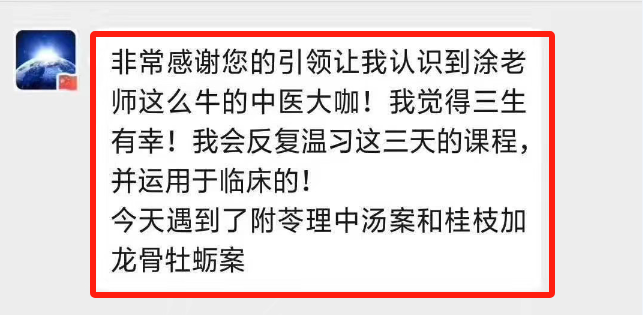
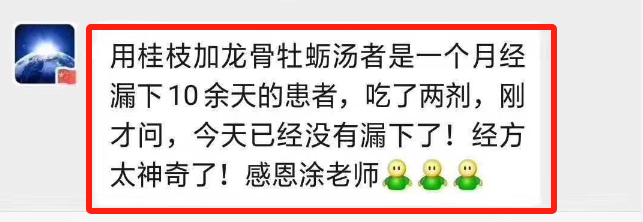
Menstrual flow lasting over 10 days
After taking two doses
It has stopped!
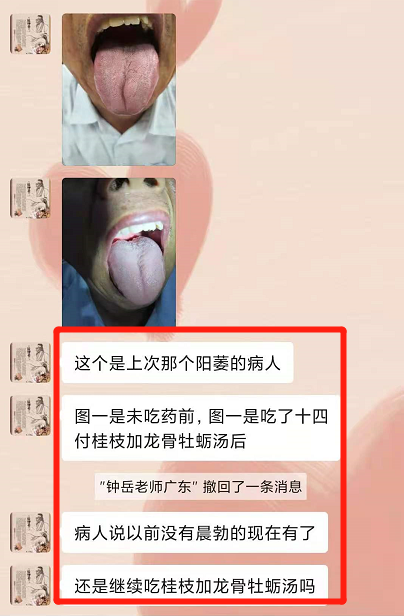
A patient with impotence took 14 dosesHis tongue appearance has significantly changed!
 Yin-Yang Disharmony: The Source of All Illnesses
Yin-Yang Disharmony: The Source of All Illnesses From the perspective of TCM, Yin and Yang not only constitute the human body but also serve as the fundamental substances that maintain life activities. The essence, blood, and body fluids within the human body belong to Yin due to their relative stillness, while Qi belongs to Yang due to its relative movement.Yin is static, guarding Yang internally; Yang is dynamic, acting for Yin externally. Essence, blood, and body fluids are Yin and guard internally, while Qi is Yang and moves externally. Therefore, if Yang Qi is insufficient, Yin fluids cannot guard internally and leak outward, leading to symptoms such as spontaneous sweating and nocturnal emissions. Treatment should focus on converging Yin and warming Yang.Clinical Applications:1InsomniaInsomnia refers to insufficient sleep time, including difficulty falling asleep, waking easily, difficulty falling back asleep, or even sleeplessness throughout the night, severely affecting our daily life.In TCM, it is called “Bu Mei,” with the pathogenesis being “Yang not entering Yin.” The characteristics of Yin Qi are calm and convergent, and at night, Yin Qi is relatively heavy.Under normal circumstances, the human body should be in a calm state. However, when the Yang Qi of the body is overly abundant and excessively active at night, it can lead to a deficiency of Yin Qi, causing mental excitement and resulting in insomnia.Additionally, if the body itself has a deficiency of Yin Qi, then its Yang Qi will appear slightly excessive, and the ability of Yin Qi to converge will decrease, also leading to insomnia and vivid dreams.Whether Yang Qi is excessive or Yin Qi is deficient, they will mutually influence each other, resulting in a state of Yin deficiency and Yang excess. Therefore, Gui Zhi Jia Long Gu Mu Li Tang, which can secure Yang Qi and converge Yin Qi, can be used for treatment.In this formula, Long Gu and Mu Li have the effect of calming the spirit. For patients with severe insomnia, additional herbs such as Fu Shen (Poria), Suan Zao Ren (Sour Jujube Seed), and Bai Zi Ren (Biota Seed) can be added.For patients with dry mouth and bitter taste, add Zhi Zi (Gardenia) and Long Dan Cao (Gentian). For those with fatigue and abdominal distension, add Huang Qi (Astragalus), Dang Gui (Angelica), and Mu Xiang (Aucklandia). For those with vivid dreams, add Shan Yu Rou (Cornelian Cherry) and Mu Dan Pi (Peony Root).2PalpitationsPalpitations refer to the patient’s subjective feeling of intense heartbeats, anxiety, and restlessness, commonly referred to as heart palpitations.When the body lacks Yin essence, blood is deficient, and Yang Qi is insufficient, it hinders the smooth circulation of blood, leading to insufficient blood flow.The brain receives signals of ischemia, prompting the body to accelerate blood pumping to restore circulation and maintain normal physiological activities, resulting in palpitations.Therefore, Gui Zhi Jia Long Gu Mu Li Tang can be used with Dang Gui (Angelica) and Sheng Di Huang (Rehmannia) to treat palpitations.Gui Zhi and Gan Cao (Licorice) have a cardiotonic effect, while Gui Zhi Jia Long Gu Mu Li Tang has a calming effect, improves cardiovascular function, and increases blood circulation.Clinically, for patients with chest tightness and shortness of breath, purple and dark tongue, and internal blood stasis, add Dan Shen (Salvia) and Chuan Xiong (Ligusticum). For those with chest tightness, abdominal distension, lower limb edema, and a thick white greasy tongue coating, indicating poor circulation of Qi and blood with phlegm accumulation, add Fu Ling (Poria) and Bai Zhu (Atractylodes).Nocturnal emissions refer to the involuntary discharge of semen in men without sexual activity or masturbation, occurring during sleep, as mentioned in the original text as “loss of essence.”This is often due to kidney Qi deficiency, insufficient Yang Qi, and deficiency of Yin essence leading to semen leakage. Frequent nocturnal emissions can excessively deplete semen, damaging Yin and Yang, resulting in both Yin and Yang deficiency.Since the 20th century, environmental issues have become a significant bottleneck restricting human society’s survival and development. Daoism, as a traditional religion native to China, has always placed great importance on protecting the natural environment. The “Laozi Xiang Er Zhu” proposes theories such as “guarding the way of harmony,” “using Qi for harmony,” and “harmony leads to mutual growth.” The Qi of “Zhong He” has the function of “harmonizing all things,” which is an important foundation for harmonious coexistence and mutual growth between humans and nature. It can be said that the essence of the “Dao” is “Zhong He,” which is natural harmony. Only with the harmony of heaven and earth can all things grow and mature. The “Zhong He Dao” is an important ideological resource for Daoism’s pursuit of harmonious life and harmonious nature.Starting from the harmonious thought of the “Zhong He Dao,” Daoism’s ecological harmony theory emphasizes the harmonious coexistence of humans and nature. “Man follows the earth, the earth follows heaven, heaven follows the Dao, and the Dao follows nature” is the principle of Daoism in handling the relationship between humans and nature, reflecting the ecological ethics of Daoism that follows nature, the ecological wisdom of the unity of heaven and man, and the ecological construction of harmony and coexistence.Dao follows nature: the ecological ethics of the Zhong He DaoThe “Zhong He Dao” embodies the harmonious ecological ethics of Daoism that follows nature. “Man follows the earth, the earth follows heaven, heaven follows the Dao, and the Dao follows nature.” The essence of the Dao is natural and spontaneous, governed by the principle of “wu wei” (non-action). The Dao gives birth to all things, which arise naturally and spontaneously, unrestrained by any external factors.The ecological ethics of “the Dao gives birth to all things.” Daoism believes that all things in heaven and earth are transformed by the Dao, thus “everything with form contains the nature of the Dao.” All things exist according to the nature endowed by the Dao, having the right to survive and develop naturally, and humans have no right to destroy them. The attitude of humans towards all things should be as stated in Ge Hong’s “Bao Pu Zi Nei Pian”: “Let things be natural,” which means to follow objective laws and coexist harmoniously with all external things to achieve overall harmony between humans and nature.The ecological ethics of “the Dao connects all things.” Daoism believes that humans and nature are a unified whole, and should respect each other and coexist harmoniously. Nature is a necessary condition for human society’s survival and development. Daoism also believes that while the Dao gives birth to all things, humans are transformed by the “Zhong He” Qi of the Dao, making them the most spiritual and intelligent beings among all things. Therefore, humans occupy the position of “the teacher of all things,” responsible for managing and caring for all things, and their actions should conform to the “heavenly way.” Humans should “assist heaven in nurturing life” and “assist the earth in nurturing form,” making nature more perfect and achieving greater harmony between themselves and nature.The ecological ethics of “the Dao values Zhong He.” Daoism emphasizes the interdependence of humans and the environment. It believes that maintaining harmony and peace in the entire natural world is a crucial premise for human survival and development. To maintain the harmonious unity between humans and nature, it is essential to ensure the peace of heaven and earth. “The Dao values Zhong He” means that human society and nature must maintain a harmonious balance. The “Taiping Jing” emphasizes that if humanity wishes for long-term peace, it must ensure that the earth, which it relies on for survival, is harmonious and peaceful. Therefore, humans must understand natural laws and act according to them to truly achieve harmonious coexistence with nature.The unity of heaven and man: the ecological wisdom of the Zhong He DaoThe Daoist scriptures state: “When heaven and earth are in harmony, all things sprout,” and “When heaven and earth are not in harmony, Yin and Yang are out of balance,” reflecting the ecological wisdom of the unity of heaven and man in Daoism. Daoism believes that humans and nature are mutually responsive and influential.The ecological wisdom of humans and nature “harmoniously coexisting.” The “Taiping Jing” states that the sun, moon, and Zhong He Qi harmoniously give birth to all things, thus in nature, the sun, moon, and Zhong He Qi are indispensable. Only when the Yin and Yang Qi are harmoniously interacting can the “Zhong He” Qi be produced, which nourishes all things, leading to peace in the natural world. The “Taiping Jing” further points out that humans are part of all things in nature, born from the natural “Zhong He” Qi, meaning that heaven, earth, and humans are all part of nature, inherently having a relationship of mutual growth and prosperity, thus they must respect each other and coexist harmoniously.The ecological wisdom of humans and nature “harmoniously coexisting.” Daoism believes that humans and nature coexist, and the quality of the natural environment directly affects the survival and development of human society. The saying “When heaven and earth are not in harmony, Yin and Yang are in error, disasters befall all people” indicates that ecological imbalance will directly impact human existence. This ecological wisdom of harmonious coexistence between humans and nature runs through various aspects of Daoist thought. For instance, in self-cultivation, Daoism emphasizes personal harmony, pursuing alignment with the Dao for longevity. Additionally, throughout history, Daoists have actively engaged in afforestation and beautifying the environment around Daoist temples, with lush pine and cypress trees providing shade, reflecting Daoism’s care for nature and environmental protection.The ecological wisdom of humans and nature “harmoniously coexisting.” Modern environmental science tells us that nature has a certain overall correlation, meaning that there are no isolated phenomena in the natural universe; everything exists in a relationship of mutual opposition, mutual generation, mutual dependence, and mutual restriction. Humans and nature are also interconnected as a whole, thus harmonious coexistence between humans and nature is an inevitable choice for human society. Daoism does not oppose the “humanization” of nature but advocates that human transformation of nature should be morally constrained, and protective measures should be taken to coexist harmoniously with all things in nature with a humble spirit. Since humans coexist with all things in heaven and earth on the same planet, being a mutually dependent community, humans, as the most spiritual beings, have the responsibility and obligation to coordinate and care for the relationships between themselves, the universe, heaven and earth, and all things in nature.Harmony and coexistence: the ecological construction of the Zhong He DaoHuman history teaches us that while enjoying rights over nature, humans must also bear the responsibility of protecting the ecological environment. The “2010 Guiyang Consensus” issued at the ecological civilization conference held last year clearly stated that “green development and addressing climate change are significant opportunities and challenges facing the international community, and are also important components of achieving our economic and social development and ecological civilization construction goals.”Daoism, starting from the thought of the “Zhong He Dao,” further elaborates on the ecological ethics of “harmony and coexistence” between humans and nature. The “Taiping Jing” states that both humans and all living things in nature have the right to exist, which is the “great virtue of heaven and earth.” “Harmony and coexistence” requires humans to live in harmony with nature, coexisting and prospering together. This is a fundamental principle for the harmonious development of humans and nature and an important aspect of modern ecological civilization construction. Today, the Daoist community in China is actively expounding and promoting Daoist ecological wisdom, practicing the “Zhong He Dao” of harmony and coexistence, and comprehensively advancing the construction of the natural ecological environment.Actively advocating ecological protection and promoting the construction of ecological Daoist temples. Daoism reveres nature and has always placed great emphasis on environmental protection. As early as 1993, at the national commendation meeting for patriotic and religious advanced individuals in the Daoist community, it actively encouraged Daoists nationwide to “plant trees and beautify the environment,” and recognized “advanced individuals in tree planting and forest protection.” In 1995, the Daoist Association of China participated in the World Religions and Environmental Protection Conference held in the UK, issuing the “Declaration on Ecological Environment Protection by Chinese Daoism” and officially joining the World Religions and Environmental Protection Federation. Since then, the Daoist community in China has taken active steps to comprehensively promote environmental protection and the construction of ecological Daoist temples, achieving significant results.Firstly, advocating tree planting and establishing ecological forest construction bases for Chinese Daoism. In early 2003, the Daoist Association of China issued an initiative to the Daoist community nationwide, planning to establish the “Ecological Forest Construction Base of Chinese Daoism” in Minqin County, Wuwei City, Gansu Province. Currently, the “base” has basically completed the tree planting task, contributing positively to the ecological and social benefits of sand prevention and control in Minqin County.Secondly, proposing the concept of “ecological Daoist temples” and holding ecological protection forums for Daoist temples. Ecological Daoist temples emphasize environmental protection to achieve the ideal of a human paradise pursued by Daoism. In 2006, the first Chinese Daoist ecological protection education workshop (the predecessor of the ecological protection forum for Daoist temples) was held, and the “Qinling Declaration” proposed the goal of building environmentally friendly Daoist temples. In 2007, the second Chinese Daoist ecological protection education workshop was held, proposing seven specific tasks, such as incorporating the land use and management of temples into regional ecological protection planning. In 2008, the third Chinese Daoist temple ecological protection forum was held, which attracted the attention of the United Nations Development Programme and received support from the World Religions and Environmental Protection Foundation. The forum released the “Ecological Daoist Temple Mao Shan Declaration,” calling for Daoist temples to “establish and improve regulations for ecological protection and publicity education, significantly enhance the ecological and environmental awareness of temple residents, and maximize the use of energy-saving technologies and materials to form a positive ecological circle in harmony with the surrounding natural environment and community.” This has expanded the activities of building ecological Daoist temples into a broader space, exploring a new path for Daoism’s participation in environmental protection.Actively carrying out environmental protection planning and promoting ecological civilization construction. In 2009, the Daoist Association of China formulated the “Eight-Year Plan for Environmental Protection in the Daoist Community (2010-2017),” which was distributed to provincial (municipal) Daoist associations. The “Outline Opinion” requires local Daoist associations and temples to study and implement it seriously, incorporating ecological protection into the goal of creating harmonious temples, contributing to the construction of ecological Daoist temples and environmental protection. The main contents of the “Outline Opinion” include: conducting ecological and environmental education to raise awareness; maximizing ecological benefits in resource use, such as rationally planning building facilities, advocating civilized incense offerings, and maximizing the protection of water resources around Daoist temples; implementing environmental awareness and actions in daily life, such as advocating a frugal lifestyle in Daoism and promoting environmentally friendly health practices; and fully utilizing various forms and channels to promote environmental protection, such as emphasizing ecological protection in all Daoist festivals and major religious activities.Actively promoting environmental protection concepts and focusing on ecological harmony construction. In terms of protecting the natural ecological environment, I believe it is essential to focus on the genuine implementation of the “three protections.” This means that while emphasizing a people-centered approach, attention must also be paid to protecting the natural environment; while emphasizing material civilization construction, ecological civilization protection must be prioritized; and while emphasizing spiritual civilization construction, the harmony of the natural ecology must be protected.In modern ecological civilization construction, I believe it is necessary to adhere to the fundamental transformation of “four concepts.” This means achieving a fundamental transformation in the concept of nature, understanding the need to respect and protect nature; achieving a fundamental transformation in values, using the moral ethics of human society to constrain the desire for unlimited consumption; achieving a fundamental transformation in ethical concepts, expanding the ethical focus to the relationship between humans and nature, respecting nature and caring for the environment; and achieving a fundamental transformation in production concepts, where humans should utilize nature under the premise of understanding, respecting, and protecting nature, and loving all things, allowing for a highly harmonious unity between humans and the entire natural ecological system.In terms of awareness of responsibility for protecting the natural environment, I believe it is necessary to implement “four measures” comprehensively. This means adhering to a sustainable development strategy, strengthening social legal system construction, increasing publicity and education efforts, and enhancing social responsibility awareness and individual consciousness.In summary, Daoism’s “Zhong He Dao” advocates an ecological concept of harmonious coexistence between humans and nature. The ecological harmony theory of the Zhong He Dao emphasizes the survival path of harmonious coexistence between humans and nature, requiring human society to always follow the ecological ethics of “Dao follows nature” and the ecological wisdom of “unity of heaven and man.” This ecological civilization thought of Daoism is something that human society must vigorously promote and advocate. Especially for modern ecological harmony construction, it has significant practical and guiding significance for building a harmonious socialist society and promoting harmonious development of the ecological environment.Therefore, Gui Zhi Jia Long Gu Mu Li Tang can be used with modifications for treatment. If accompanied by dream intercourse, Shan Yu Rou (Cornelian Cherry), Wu Wei Zi (Schisandra), and Qian Shi (Euryale) can be added to secure and consolidate.Precautions:1. Avoid eating seaweed, raw scallions, and pork.2. Avoid raw, cold, and greasy foods, and avoid drinking cold water.3. Pregnant women and women during menstruation should use with caution.Please share this article to let more people see it.Promote TCM cultureSpread TCM knowledgeLet’s practice together
From the perspective of TCM, Yin and Yang not only constitute the human body but also serve as the fundamental substances that maintain life activities. The essence, blood, and body fluids within the human body belong to Yin due to their relative stillness, while Qi belongs to Yang due to its relative movement.Yin is static, guarding Yang internally; Yang is dynamic, acting for Yin externally. Essence, blood, and body fluids are Yin and guard internally, while Qi is Yang and moves externally. Therefore, if Yang Qi is insufficient, Yin fluids cannot guard internally and leak outward, leading to symptoms such as spontaneous sweating and nocturnal emissions. Treatment should focus on converging Yin and warming Yang.Clinical Applications:1InsomniaInsomnia refers to insufficient sleep time, including difficulty falling asleep, waking easily, difficulty falling back asleep, or even sleeplessness throughout the night, severely affecting our daily life.In TCM, it is called “Bu Mei,” with the pathogenesis being “Yang not entering Yin.” The characteristics of Yin Qi are calm and convergent, and at night, Yin Qi is relatively heavy.Under normal circumstances, the human body should be in a calm state. However, when the Yang Qi of the body is overly abundant and excessively active at night, it can lead to a deficiency of Yin Qi, causing mental excitement and resulting in insomnia.Additionally, if the body itself has a deficiency of Yin Qi, then its Yang Qi will appear slightly excessive, and the ability of Yin Qi to converge will decrease, also leading to insomnia and vivid dreams.Whether Yang Qi is excessive or Yin Qi is deficient, they will mutually influence each other, resulting in a state of Yin deficiency and Yang excess. Therefore, Gui Zhi Jia Long Gu Mu Li Tang, which can secure Yang Qi and converge Yin Qi, can be used for treatment.In this formula, Long Gu and Mu Li have the effect of calming the spirit. For patients with severe insomnia, additional herbs such as Fu Shen (Poria), Suan Zao Ren (Sour Jujube Seed), and Bai Zi Ren (Biota Seed) can be added.For patients with dry mouth and bitter taste, add Zhi Zi (Gardenia) and Long Dan Cao (Gentian). For those with fatigue and abdominal distension, add Huang Qi (Astragalus), Dang Gui (Angelica), and Mu Xiang (Aucklandia). For those with vivid dreams, add Shan Yu Rou (Cornelian Cherry) and Mu Dan Pi (Peony Root).2PalpitationsPalpitations refer to the patient’s subjective feeling of intense heartbeats, anxiety, and restlessness, commonly referred to as heart palpitations.When the body lacks Yin essence, blood is deficient, and Yang Qi is insufficient, it hinders the smooth circulation of blood, leading to insufficient blood flow.The brain receives signals of ischemia, prompting the body to accelerate blood pumping to restore circulation and maintain normal physiological activities, resulting in palpitations.Therefore, Gui Zhi Jia Long Gu Mu Li Tang can be used with Dang Gui (Angelica) and Sheng Di Huang (Rehmannia) to treat palpitations.Gui Zhi and Gan Cao (Licorice) have a cardiotonic effect, while Gui Zhi Jia Long Gu Mu Li Tang has a calming effect, improves cardiovascular function, and increases blood circulation.Clinically, for patients with chest tightness and shortness of breath, purple and dark tongue, and internal blood stasis, add Dan Shen (Salvia) and Chuan Xiong (Ligusticum). For those with chest tightness, abdominal distension, lower limb edema, and a thick white greasy tongue coating, indicating poor circulation of Qi and blood with phlegm accumulation, add Fu Ling (Poria) and Bai Zhu (Atractylodes).Nocturnal emissions refer to the involuntary discharge of semen in men without sexual activity or masturbation, occurring during sleep, as mentioned in the original text as “loss of essence.”This is often due to kidney Qi deficiency, insufficient Yang Qi, and deficiency of Yin essence leading to semen leakage. Frequent nocturnal emissions can excessively deplete semen, damaging Yin and Yang, resulting in both Yin and Yang deficiency.Since the 20th century, environmental issues have become a significant bottleneck restricting human society’s survival and development. Daoism, as a traditional religion native to China, has always placed great importance on protecting the natural environment. The “Laozi Xiang Er Zhu” proposes theories such as “guarding the way of harmony,” “using Qi for harmony,” and “harmony leads to mutual growth.” The Qi of “Zhong He” has the function of “harmonizing all things,” which is an important foundation for harmonious coexistence and mutual growth between humans and nature. It can be said that the essence of the “Dao” is “Zhong He,” which is natural harmony. Only with the harmony of heaven and earth can all things grow and mature. The “Zhong He Dao” is an important ideological resource for Daoism’s pursuit of harmonious life and harmonious nature.Starting from the harmonious thought of the “Zhong He Dao,” Daoism’s ecological harmony theory emphasizes the harmonious coexistence of humans and nature. “Man follows the earth, the earth follows heaven, heaven follows the Dao, and the Dao follows nature” is the principle of Daoism in handling the relationship between humans and nature, reflecting the ecological ethics of Daoism that follows nature, the ecological wisdom of the unity of heaven and man, and the ecological construction of harmony and coexistence.Dao follows nature: the ecological ethics of the Zhong He DaoThe “Zhong He Dao” embodies the harmonious ecological ethics of Daoism that follows nature. “Man follows the earth, the earth follows heaven, heaven follows the Dao, and the Dao follows nature.” The essence of the Dao is natural and spontaneous, governed by the principle of “wu wei” (non-action). The Dao gives birth to all things, which arise naturally and spontaneously, unrestrained by any external factors.The ecological ethics of “the Dao gives birth to all things.” Daoism believes that all things in heaven and earth are transformed by the Dao, thus “everything with form contains the nature of the Dao.” All things exist according to the nature endowed by the Dao, having the right to survive and develop naturally, and humans have no right to destroy them. The attitude of humans towards all things should be as stated in Ge Hong’s “Bao Pu Zi Nei Pian”: “Let things be natural,” which means to follow objective laws and coexist harmoniously with all external things to achieve overall harmony between humans and nature.The ecological ethics of “the Dao connects all things.” Daoism believes that humans and nature are a unified whole, and should respect each other and coexist harmoniously. Nature is a necessary condition for human society’s survival and development. Daoism also believes that while the Dao gives birth to all things, humans are transformed by the “Zhong He” Qi of the Dao, making them the most spiritual and intelligent beings among all things. Therefore, humans occupy the position of “the teacher of all things,” responsible for managing and caring for all things, and their actions should conform to the “heavenly way.” Humans should “assist heaven in nurturing life” and “assist the earth in nurturing form,” making nature more perfect and achieving greater harmony between themselves and nature.The ecological ethics of “the Dao values Zhong He.” Daoism emphasizes the interdependence of humans and the environment. It believes that maintaining harmony and peace in the entire natural world is a crucial premise for human survival and development. To maintain the harmonious unity between humans and nature, it is essential to ensure the peace of heaven and earth. “The Dao values Zhong He” means that human society and nature must maintain a harmonious balance. The “Taiping Jing” emphasizes that if humanity wishes for long-term peace, it must ensure that the earth, which it relies on for survival, is harmonious and peaceful. Therefore, humans must understand natural laws and act according to them to truly achieve harmonious coexistence with nature.The unity of heaven and man: the ecological wisdom of the Zhong He DaoThe Daoist scriptures state: “When heaven and earth are in harmony, all things sprout,” and “When heaven and earth are not in harmony, Yin and Yang are out of balance,” reflecting the ecological wisdom of the unity of heaven and man in Daoism. Daoism believes that humans and nature are mutually responsive and influential.The ecological wisdom of humans and nature “harmoniously coexisting.” The “Taiping Jing” states that the sun, moon, and Zhong He Qi harmoniously give birth to all things, thus in nature, the sun, moon, and Zhong He Qi are indispensable. Only when the Yin and Yang Qi are harmoniously interacting can the “Zhong He” Qi be produced, which nourishes all things, leading to peace in the natural world. The “Taiping Jing” further points out that humans are part of all things in nature, born from the natural “Zhong He” Qi, meaning that heaven, earth, and humans are all part of nature, inherently having a relationship of mutual growth and prosperity, thus they must respect each other and coexist harmoniously.The ecological wisdom of humans and nature “harmoniously coexisting.” Daoism believes that humans and nature coexist, and the quality of the natural environment directly affects the survival and development of human society. The saying “When heaven and earth are not in harmony, Yin and Yang are in error, disasters befall all people” indicates that ecological imbalance will directly impact human existence. This ecological wisdom of harmonious coexistence between humans and nature runs through various aspects of Daoist thought. For instance, in self-cultivation, Daoism emphasizes personal harmony, pursuing alignment with the Dao for longevity. Additionally, throughout history, Daoists have actively engaged in afforestation and beautifying the environment around Daoist temples, with lush pine and cypress trees providing shade, reflecting Daoism’s care for nature and environmental protection.The ecological wisdom of humans and nature “harmoniously coexisting.” Modern environmental science tells us that nature has a certain overall correlation, meaning that there are no isolated phenomena in the natural universe; everything exists in a relationship of mutual opposition, mutual generation, mutual dependence, and mutual restriction. Humans and nature are also interconnected as a whole, thus harmonious coexistence between humans and nature is an inevitable choice for human society. Daoism does not oppose the “humanization” of nature but advocates that human transformation of nature should be morally constrained, and protective measures should be taken to coexist harmoniously with all things in nature with a humble spirit. Since humans coexist with all things in heaven and earth on the same planet, being a mutually dependent community, humans, as the most spiritual beings, have the responsibility and obligation to coordinate and care for the relationships between themselves, the universe, heaven and earth, and all things in nature.Harmony and coexistence: the ecological construction of the Zhong He DaoHuman history teaches us that while enjoying rights over nature, humans must also bear the responsibility of protecting the ecological environment. The “2010 Guiyang Consensus” issued at the ecological civilization conference held last year clearly stated that “green development and addressing climate change are significant opportunities and challenges facing the international community, and are also important components of achieving our economic and social development and ecological civilization construction goals.”Daoism, starting from the thought of the “Zhong He Dao,” further elaborates on the ecological ethics of “harmony and coexistence” between humans and nature. The “Taiping Jing” states that both humans and all living things in nature have the right to exist, which is the “great virtue of heaven and earth.” “Harmony and coexistence” requires humans to live in harmony with nature, coexisting and prospering together. This is a fundamental principle for the harmonious development of humans and nature and an important aspect of modern ecological civilization construction. Today, the Daoist community in China is actively expounding and promoting Daoist ecological wisdom, practicing the “Zhong He Dao” of harmony and coexistence, and comprehensively advancing the construction of the natural ecological environment.Actively advocating ecological protection and promoting the construction of ecological Daoist temples. Daoism reveres nature and has always placed great emphasis on environmental protection. As early as 1993, at the national commendation meeting for patriotic and religious advanced individuals in the Daoist community, it actively encouraged Daoists nationwide to “plant trees and beautify the environment,” and recognized “advanced individuals in tree planting and forest protection.” In 1995, the Daoist Association of China participated in the World Religions and Environmental Protection Conference held in the UK, issuing the “Declaration on Ecological Environment Protection by Chinese Daoism” and officially joining the World Religions and Environmental Protection Federation. Since then, the Daoist community in China has taken active steps to comprehensively promote environmental protection and the construction of ecological Daoist temples, achieving significant results.Firstly, advocating tree planting and establishing ecological forest construction bases for Chinese Daoism. In early 2003, the Daoist Association of China issued an initiative to the Daoist community nationwide, planning to establish the “Ecological Forest Construction Base of Chinese Daoism” in Minqin County, Wuwei City, Gansu Province. Currently, the “base” has basically completed the tree planting task, contributing positively to the ecological and social benefits of sand prevention and control in Minqin County.Secondly, proposing the concept of “ecological Daoist temples” and holding ecological protection forums for Daoist temples. Ecological Daoist temples emphasize environmental protection to achieve the ideal of a human paradise pursued by Daoism. In 2006, the first Chinese Daoist ecological protection education workshop (the predecessor of the ecological protection forum for Daoist temples) was held, and the “Qinling Declaration” proposed the goal of building environmentally friendly Daoist temples. In 2007, the second Chinese Daoist ecological protection education workshop was held, proposing seven specific tasks, such as incorporating the land use and management of temples into regional ecological protection planning. In 2008, the third Chinese Daoist temple ecological protection forum was held, which attracted the attention of the United Nations Development Programme and received support from the World Religions and Environmental Protection Foundation. The forum released the “Ecological Daoist Temple Mao Shan Declaration,” calling for Daoist temples to “establish and improve regulations for ecological protection and publicity education, significantly enhance the ecological and environmental awareness of temple residents, and maximize the use of energy-saving technologies and materials to form a positive ecological circle in harmony with the surrounding natural environment and community.” This has expanded the activities of building ecological Daoist temples into a broader space, exploring a new path for Daoism’s participation in environmental protection.Actively carrying out environmental protection planning and promoting ecological civilization construction. In 2009, the Daoist Association of China formulated the “Eight-Year Plan for Environmental Protection in the Daoist Community (2010-2017),” which was distributed to provincial (municipal) Daoist associations. The “Outline Opinion” requires local Daoist associations and temples to study and implement it seriously, incorporating ecological protection into the goal of creating harmonious temples, contributing to the construction of ecological Daoist temples and environmental protection. The main contents of the “Outline Opinion” include: conducting ecological and environmental education to raise awareness; maximizing ecological benefits in resource use, such as rationally planning building facilities, advocating civilized incense offerings, and maximizing the protection of water resources around Daoist temples; implementing environmental awareness and actions in daily life, such as advocating a frugal lifestyle in Daoism and promoting environmentally friendly health practices; and fully utilizing various forms and channels to promote environmental protection, such as emphasizing ecological protection in all Daoist festivals and major religious activities.Actively promoting environmental protection concepts and focusing on ecological harmony construction. In terms of protecting the natural ecological environment, I believe it is essential to focus on the genuine implementation of the “three protections.” This means that while emphasizing a people-centered approach, attention must also be paid to protecting the natural environment; while emphasizing material civilization construction, ecological civilization protection must be prioritized; and while emphasizing spiritual civilization construction, the harmony of the natural ecology must be protected.In modern ecological civilization construction, I believe it is necessary to adhere to the fundamental transformation of “four concepts.” This means achieving a fundamental transformation in the concept of nature, understanding the need to respect and protect nature; achieving a fundamental transformation in values, using the moral ethics of human society to constrain the desire for unlimited consumption; achieving a fundamental transformation in ethical concepts, expanding the ethical focus to the relationship between humans and nature, respecting nature and caring for the environment; and achieving a fundamental transformation in production concepts, where humans should utilize nature under the premise of understanding, respecting, and protecting nature, and loving all things, allowing for a highly harmonious unity between humans and the entire natural ecological system.In terms of awareness of responsibility for protecting the natural environment, I believe it is necessary to implement “four measures” comprehensively. This means adhering to a sustainable development strategy, strengthening social legal system construction, increasing publicity and education efforts, and enhancing social responsibility awareness and individual consciousness.In summary, Daoism’s “Zhong He Dao” advocates an ecological concept of harmonious coexistence between humans and nature. The ecological harmony theory of the Zhong He Dao emphasizes the survival path of harmonious coexistence between humans and nature, requiring human society to always follow the ecological ethics of “Dao follows nature” and the ecological wisdom of “unity of heaven and man.” This ecological civilization thought of Daoism is something that human society must vigorously promote and advocate. Especially for modern ecological harmony construction, it has significant practical and guiding significance for building a harmonious socialist society and promoting harmonious development of the ecological environment.Therefore, Gui Zhi Jia Long Gu Mu Li Tang can be used with modifications for treatment. If accompanied by dream intercourse, Shan Yu Rou (Cornelian Cherry), Wu Wei Zi (Schisandra), and Qian Shi (Euryale) can be added to secure and consolidate.Precautions:1. Avoid eating seaweed, raw scallions, and pork.2. Avoid raw, cold, and greasy foods, and avoid drinking cold water.3. Pregnant women and women during menstruation should use with caution.Please share this article to let more people see it.Promote TCM cultureSpread TCM knowledgeLet’s practice together




Copyright Statement: Copyright belongs to the relevant rights holders, this article is sourced from the internet for learning and reference only. This public account is used for academic exchange only, if it infringes your rights, please notify us to delete it in a timely manner. Respect knowledge and labor, please retain copyright information when reprinting.
Previous Highlights
Did you know? Eating dumplings on the winter solstice is to commemorate the “Medical Sage” Zhang Zhongjing. The activity of leaving comments to win prizes has ended, and the prizes have been distributed!
A Chinese patent medicine that dispels wind, cold, and dampness from the joints, warming them up.
The “golden period” of health preservation during the winter solstice is here; how to maintain health is covered in this article!


Tutor Tu Huaxin’s video account and Douyin account have been opened; please pay more attention~~
Your comments and likes are the greatest recognition for Teacher Tu and the biggest promotion for the development of TCM.
Friends of the Medical Sage, when gathered, are a fire; when scattered, are stars in the sky.



